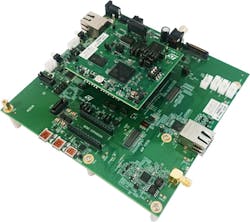STmicroeletronics’ (STmicro) Modular Telematics Platform (MTP) is a system solution enables developers to quickly start development of automotive telematics systems using the Telemaco3P Secure Telematics Processor (see photo). The platform bundles the processing node of a telematic system with a GNSS positioning node. The positioning node is based on the multiconstellation, single-band TeseoIII chip that provides GyroAcc dear reckoning capability. The MTP can also support STMicro’s multiconstellation, dual-band chips.
The platform supports cellular wireless connectivity in addition to optional Bluetooth and Wi-Fi support. There is an expansion connection for V2X connectivity that works with the Autotalks V2X platform. The board supports all major automotive networks, including CAN-FD, Flexray, and BroadR-Reach 100Base-T1 Ethernet. In addition, the system has dual Gbit Ethernet controllers with AVB support. There are also SDIO and USB 2.0 interfaces.
The Telemaco3P STA1385 is AEC-Q100 qualified Grade 2 and it is designed to be a cost-effective processing solution for innovative telematics and connectivity applications. It is based on a dual, 600-MHz Cortex-A7 SoC with an embedded and independent Hardware Security Module (HSM). There is also an isolated sub-system based on ARM Cortex-M3 for vehicle CAN interface. It also has access to the full set of standard connectivity interfaces. The Cortex-M3 has 256 Kbytes of reserved SRAM that can be extended up to 768 Kbytes. The system supports 16-bit DDR3L/LPDDR2, and it has an 8-bit NAND interface.
The HSM includes cryptographic functions accelerators and a true random number generator. It supports AES, RSA, and ECC keys, along with MD5, SHA1, SHA2, and SHA3 hashes. The anti-tamper security support has provision for an ST SECURE Element device (ST33) to achieve security protection levels above the ones provided by the HSM. The system is designed to provide secure boot, software roll-back protection, secure Electronic-Control-Unit (ECU) Firmware-Over-The-Air (FOTA) upgrade, and I/O channel encryption. The chip also implements ARM TrustZone protection.
About the Author
William G. Wong
Senior Content Director - Electronic Design and Microwaves & RF
I am Editor of Electronic Design focusing on embedded, software, and systems. As Senior Content Director, I also manage Microwaves & RF and I work with a great team of editors to provide engineers, programmers, developers and technical managers with interesting and useful articles and videos on a regular basis. Check out our free newsletters to see the latest content.
You can send press releases for new products for possible coverage on the website. I am also interested in receiving contributed articles for publishing on our website. Use our template and send to me along with a signed release form.
Check out my blog, AltEmbedded on Electronic Design, as well as his latest articles on this site that are listed below.
You can visit my social media via these links:
- AltEmbedded on Electronic Design
- Bill Wong on Facebook
- @AltEmbedded on Twitter
- Bill Wong on LinkedIn
I earned a Bachelor of Electrical Engineering at the Georgia Institute of Technology and a Masters in Computer Science from Rutgers University. I still do a bit of programming using everything from C and C++ to Rust and Ada/SPARK. I do a bit of PHP programming for Drupal websites. I have posted a few Drupal modules.
I still get a hand on software and electronic hardware. Some of this can be found on our Kit Close-Up video series. You can also see me on many of our TechXchange Talk videos. I am interested in a range of projects from robotics to artificial intelligence.



